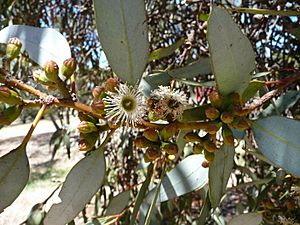Dumosa mallee facts for kids
Quick facts for kids Dumosa Mallee |
|
|---|---|
 |
|
| Eucalyptus dumosa in the Nombinnie Nature Reserve | |
| Scientific classification | |
| Genus: |
Eucalyptus
|
| Species: |
dumosa
|
 |
|
| E. dumosa, field distribution | |
The Eucalyptus dumosa, often called the white mallee, dumosa mallee, or Congoo mallee, is a unique type of mallee tree. It grows only in south eastern Australia. This tree usually has rough, flaky grey bark on its lower trunk. The bark higher up is smooth. It has long, narrow adult leaves, and its flower buds grow in groups of seven. When it blooms, it has white flowers. Its fruit looks like a cup, cylinder, or barrel.
Contents
What Does the Dumosa Mallee Look Like?
The Eucalyptus dumosa is a type of mallee. Mallees are trees that grow many stems from the ground. This tree usually reaches a height of 4 to 10 meters (about 13 to 33 feet). Sometimes, it can grow up to 12 meters (about 39 feet) tall. It also spreads out, becoming 4 to 5 meters (about 13 to 16 feet) wide. It has an open, bushy shape.
Its Bark
The bark at the bottom of the trunk is usually rough and flaky. It can be greyish or fibrous. Higher up, the bark is smooth and can be whitish or yellow-white. Over time, this smooth bark turns grey or pinkish-grey. The bark peels off in long, thin strips.
Its Leaves and Flowers
Young plants and new shoots have egg-shaped leaves. These leaves are 55 to 140 millimeters (about 2 to 5.5 inches) long. They are 22 to 70 millimeters (about 0.9 to 2.8 inches) wide. These young leaves have a small stalk called a petiole.
Adult leaves are a dull bluish-green or greyish-green on both sides. They are shaped like a spear or are slightly curved. These leaves are 48 to 120 millimeters (about 1.9 to 4.7 inches) long. They are 8 to 25 millimeters (about 0.3 to 1 inch) wide. Each adult leaf also has a petiole, which is 8 to 25 millimeters long.
The flower buds grow in groups of seven. They are found where the leaves meet the stem. Each group of buds sits on a stalk called a peduncle, which is 5 to 20 millimeters (about 0.2 to 0.8 inches) long. Each individual bud has a smaller stalk called a pedicel, 2 to 5 millimeters (about 0.08 to 0.2 inches) long.
Mature buds are shaped like a cylinder. They can be green or red. They are 6 to 11 millimeters (about 0.2 to 0.4 inches) long and 3 to 5 millimeters (about 0.1 to 0.2 inches) wide. The top part of the bud, called the operculum, is conical or turban-shaped and has stripes.
The Eucalyptus dumosa flowers from late summer to mid-autumn. Its flowers are white. After flowering, it produces a woody fruit. This fruit is a capsule shaped like a cup, cylinder, or barrel. It is 4 to 9 millimeters (about 0.16 to 0.35 inches) long and 5 to 7 millimeters (about 0.2 to 0.28 inches) wide.
How the Dumosa Mallee Got Its Name
The name Eucalyptus dumosa was first written about in 1820. This was in a book by John Oxley about his trips into New South Wales. Oxley wrote that the botanist Allan Cunningham used this name. Cunningham was with Oxley on his journey.
Oxley described "dreadful scrubs of eucalyptus dumosa." He also mentioned "thick brushes of eucalyptus" that spread everywhere. He called them "the dwarf gum" because they never grew taller than 20 feet (about 6 meters). They spread out from their roots, making it hard to see far.
The second part of the scientific name, dumosa, is a Latin word. It means "bushy." This name describes how the plant grows in a bushy way.
Where the Dumosa Mallee Grows
The white mallee grows in the drier parts of Australia. You can find it in South Australia, from the northern Flinders Ranges to the Murray Mallee. It also grows eastwards to Dubbo in central western New South Wales. You can also find it in Swan Hill in north western Victoria. It is one of the most common mallee types found across Australia.
How People Use the Dumosa Mallee
The leaves of the Eucalyptus dumosa are used to make eucalyptus oil. This oil is made by a process called steam distillation. It is a source of a substance called cineole.
Planting and Land Care
This tree is often planted in large groups with other mallee species. It is used along wide roadsides. It helps to create a screen, block wind, and stop soil from washing away (erosion control). It also provides shade for farm animals.
Traditional Uses
Aboriginal people have used this tree for many things. They get food, drinks, and medicines from it. They also use it to make containers and tools.
A sweet, sticky substance, like manna, forms on the leaves. This can be made into a drink. The bark from young roots can be baked and eaten. It tastes sweet, a bit like malt.
In the past, people noted that these trees could provide water from their roots. They also mentioned a type of manna called Lerp or Larp. This was eaten by Aboriginal people in the mallee country of Victoria during summer. It looks like small shells and is sweet and white or yellowish-white. This substance is made by an insect called Psylla Eucalypti.
Other Benefits
The Eucalyptus dumosa is also good for producing a lot of plant material, called biomass. It can produce 10 to 20 tons per hectare each year. In farming areas, like the wheatbelt regions, this tree is very helpful. It can reduce salt in the soil, give shade to animals, act as a windbreak, and help prevent soil erosion.
See also
 In Spanish: Mallee blanco para niños
In Spanish: Mallee blanco para niños


